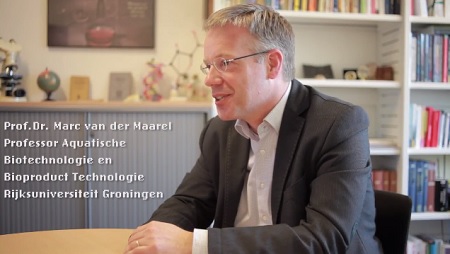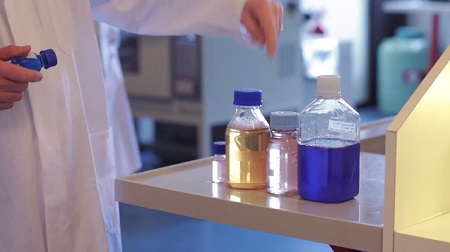Feeling blue about patent application
University of Groningen researcher Mark van der Maarel discovered a new blue colouring by chance. The patent application has just been published, but is unlikely to result in much. His discovery will benefit students though.
Blue wine was the biggest bar trend this summer. ‘The blue usually comes from a pigment in grape skins’, says Van der Maarel, Professor of Aquatic Biotechnology and Bioproduct Technology at the Engineering and Technology Institute Groningen . Other foodstuffs often contain synthetic colourings, which appear on the packaging as E131, E132 and E133. Synthetic colourings have recently gained somewhat of a bad name, and supermarket chains such as Albert Heijn and Jumbo have said that they will ban some of them.

‘That means there is a demand for natural food colouring, and it looked like we had just that’, explains Van der Maarel. A PhD student was working with algae from a hot spring near a volcano on Java, Indonesia. ‘When she rinsed the algae with clean water it turned blue.’
Blue pigment has been found in algae before: Spirulina, which can be found in health-food shops, also produces it. But as Van der Maarel’s Cyanidioschyzon merolae grows in hot springs, the blue pigment from this alga was expected to be more stable at the high temperatures that are sometimes used to pasteurize food. ‘And it might also be stable in an acidic environment.’ Useful for anyone wanting to make blue cola.
The patent application was written and recently published , but it now looks unlikely that the blue algae colouring will take the food industry by storm. ‘The stability is rather disappointing and a huge amount of work is needed to turn it into a marketable product.’ An investment of a few million and five or six years of research, Van der Maarel estimates. Industrial partners are not beating a path to his door to make such an investment, because if the dye does need to be chemically modified before use it will no longer count as ‘natural’.

It is questionable whether the patent will be awarded at all. ‘A patent must be innovative. A colouring from algae that grow at high temperatures and can thus withstand high temperatures may not suffice.’ Despite this, Van der Maarel has found an application for the colouring. ‘It is an inspiring example during practicals, for students and school pupils.’
In these practicals, Van der Maarel covers topical issues such as the growing demand for natural colourings. ‘Then they get to extract the pigment from the algae themselves and experiment with it. How stable is it? How much do you need to make a wine gum completely blue? Alongside temperature and acidity, alcohol, for example, also has an effect. ‘The drink Blue Curacao is actually alcohol with sugar and colouring.’ Van der Maarel’s algae food colouring already decolorizes at 10 percent alcohol, which is fine for wine but not for Blue Curacao.
In class, students look for products containing synthetic blue colouring and find out how to replace this. ‘The link to everyday life is very inspiring.’ They also have to think about why algae use such a pigment (spoiler: so as to absorb more sunlight for photosynthesis). So although Van der Maarel could be feeling blue about the patent application, he is actually most satisfied with his new colouring.
| Last modified: | 01 June 2020 10.27 a.m. |
More news
-
13 May 2024
Trapping molecules
In his laboratory, physicist Steven Hoekstra is building an experimental set-up made of two parts: one that produces barium fluoride molecules, and a second part that traps the molecules and brings them to an almost complete standstill so they can...
-
29 April 2024
Tactile sensors
Every two weeks, UG Makers puts the spotlight on a researcher who has created something tangible, ranging from homemade measuring equipment for academic research to small or larger products that can change our daily lives. That is how UG...
-
16 April 2024
UG signs Barcelona Declaration on Open Research Information
In a significant stride toward advancing responsible research assessment and open science, the University of Groningen has officially signed the Barcelona Declaration on Open Research Information.

